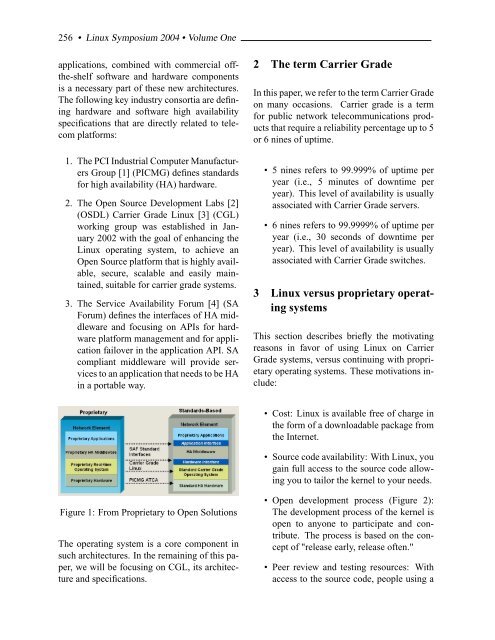Create successful ePaper yourself
Turn your PDF publications into a flip-book with our unique Google optimized e-Paper software.
256 • <strong>Linux</strong> Symposium 2004 • Volume <strong>One</strong><br />
applications, combined with commercial offthe-shelf<br />
software and hardware components<br />
is a necessary part of these new architectures.<br />
<strong>The</strong> following key industry consortia are defining<br />
hardware and software high availability<br />
specifications that are directly related to telecom<br />
platforms:<br />
1. <strong>The</strong> PCI Industrial Computer Manufacturers<br />
Group [1] (PICMG) defines standards<br />
for high availability (HA) hardware.<br />
2. <strong>The</strong> Open Source Development Labs [2]<br />
(OSDL) Carrier Grade <strong>Linux</strong> [3] (CGL)<br />
working group was established in January<br />
2002 with the goal of enhancing the<br />
<strong>Linux</strong> operating system, to achieve an<br />
Open Source platform that is highly available,<br />
secure, scalable and easily maintained,<br />
suitable for carrier grade systems.<br />
3. <strong>The</strong> Service Availability Forum [4] (SA<br />
Forum) defines the interfaces of HA middleware<br />
and focusing on APIs for hardware<br />
platform management and for application<br />
failover in the application API. SA<br />
compliant middleware will provide services<br />
to an application that needs to be HA<br />
in a portable way.<br />
2 <strong>The</strong> term Carrier Grade<br />
In this paper, we refer to the term Carrier Grade<br />
on many occasions. Carrier grade is a term<br />
for public network telecommunications products<br />
that require a reliability percentage up to 5<br />
or 6 nines of uptime.<br />
• 5 nines refers to 99.999% of uptime per<br />
year (i.e., 5 minutes of downtime per<br />
year). This level of availability is usually<br />
associated with Carrier Grade servers.<br />
• 6 nines refers to 99.9999% of uptime per<br />
year (i.e., 30 seconds of downtime per<br />
year). This level of availability is usually<br />
associated with Carrier Grade switches.<br />
3 <strong>Linux</strong> versus proprietary operating<br />
systems<br />
This section describes briefly the motivating<br />
reasons in favor of using <strong>Linux</strong> on Carrier<br />
Grade systems, versus continuing with proprietary<br />
operating systems. <strong>The</strong>se motivations include:<br />
• Cost: <strong>Linux</strong> is available free of charge in<br />
the form of a downloadable package from<br />
the Internet.<br />
• Source code availability: With <strong>Linux</strong>, you<br />
gain full access to the source code allowing<br />
you to tailor the kernel to your needs.<br />
Figure 1: From Proprietary to Open Solutions<br />
<strong>The</strong> operating system is a core component in<br />
such architectures. In the remaining of this paper,<br />
we will be focusing on CGL, its architecture<br />
and specifications.<br />
• Open development process (Figure 2):<br />
<strong>The</strong> development process of the kernel is<br />
open to anyone to participate and contribute.<br />
<strong>The</strong> process is based on the concept<br />
of "release early, release often."<br />
• Peer review and testing resources: With<br />
access to the source code, people using a

















